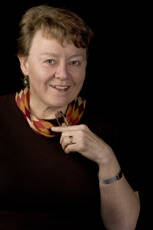At the Casa, the Franciscan Renewal Center in Scottsdale, Ariz., where I recently made a retreat, a participant told me, “Volunteers do nearly everything here.” A few friars could not accomplish all that the center does. It operates a conventual parish and puts on such excellent liturgies that thousands of worshippers attend its Holy Week services outdoors in the desert foothills. It also maintains a bookstore and sponsors retreats, counseling services, and educational and social action programs. Her comment bolsters what a friend who visited the Casa several years ago, said, “The daily prayer is led entirely by laypeople.” (For more on my retreat, see America’s blog, In All Things).
New forms of leadership are emerging around the nation as parishes of vastly different descriptions address changing circumstances and extend their mission. A close look shows that new structures and models are being tried and that many of them are successful.
For six years, the project called Emerging Models of Pastoral Leadership has played a unique role in this nationwide transition, commissioning analytic research, convening leaders who otherwise would neither see nor hear one another, and processing what is being learned. Now that project has joined with Loyola Press to publish Shaping Catholic Parishes, the first in a series of resources, edited by Carole Ganim. The appearance of this volume of 22 first-person accounts coincides with the project’s National Ministry Summit 2008, which takes place on April 20-23 in Orlando, Fla. I’ll be there.
Models show how some people have achieved their goals in ways that can be imitated and adapted. One learns, for example, from a parishioner’s account how an evening Sunday Mass at St. Vincent de Paul parish in San Francisco has come to be “filled with young adults in their 20s and 30s being served by lectors, eucharistic ministers and ushers of the same age.”
As a genre, success stories in which a parish overcomes obstacles can be irresistible. Even when briefly told, as these are, an authentic voice rings out.
“We had to find a way to enable people to be part of the community that would not become another burden or an addition to a long list of things they needed to do,” writes a sister about a mostly Caribbean parish in Queens, N.Y., that is filled with single parents and parishioners working more than one job.
In another account, a parish council came up $11,000 shy of what it needed to pay for a new building. A quiet 88-year-old proposed, “If 11 people sacrificed and gave $1,000 each, the money could be easily raised.” Ten minutes later she returned “with pledges adding up to $11,000.” The incident took place in a rural Oklahoma parish of 120 families with no resident pastor and no paid staff. Committed volunteers maintain a hospital ministry team, an ecumenical grief-support group, a food-sack program for hungry travelers and an annual car show, the proceeds from which enable the parish to buy “a coat for every needy child in the county.”
One more example: When a beloved young pastor died at the Cristo Rey parish in Seattle, the bishop sent not a resident priest, but a female pastoral life director to lead the grieving parishioners. “To them I was a slap in the face,” she writes. She spent her first year poring over the names of the 2,000 families in the parish directory, praying for them page by page. She also asked the parishioners to pray for one another “one page each night.” Over nine years, she and the two non-resident priests who work with her as a team built unity in the half-Anglo, half-Hispanic parish.
Such stories show the uniqueness and importance of parishes—the local lifeline of the worldwide church. One can also see in these developments an immense potential for reform, even transformation, presenting itself to the church now in two respects. First, the church is beginning to acknowledge and extend the range of leadership by women. (Arguably this is an area in which the early Christians were ahead of us.) Second, the church’s en-riched theology of baptism—one that leads to a universal Christian vocation to discipleship and mission—has led laypeople to respond to the call to religious leadership, no longer leaving pastoral care solely to clergy and religious. These two developments hold such promise in terms of new energy, spiritual gifts and the sheer number of Christians who could become engaged and active, that a revival of staggering proportions might eventually be the result.








